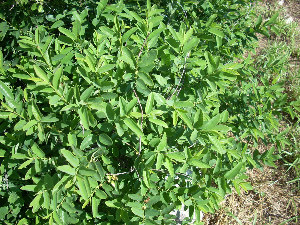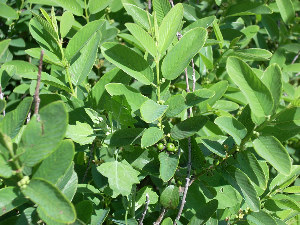Coyotillo, Tullidora
Karwinskia humboldtiana (Schult.) Zucc.
Rhamnaceae (Buckthorn Family)
Coyotillo is a small, evergreen shrub with deep green, almost glossy and distinctively veined leaves that grow opposite each other along the stem. The small, greenish flowers produce a green fruit that ripens to a dark purple-black color. The small (about 1/2-inch) globular fruit is attractive, has a sweet juicy pulp when ripe, and resembles many small, dark fruits in the Buckthorn family. However, the leaves and the fruit, especially the seed inside the exocarp contain deadly neurotoxins. Its common name in Mexico, tullidora, is rendered from the verb "tullir," to cripple. Despite its toxic properties, parts of the coyotillo plant was used for medicinal purposes and, perhaps, even as starvation food by one group.
It is a widespread component of shrubby landscape on the southwestern edge of the Edwards Plateau, and its range extends into the south Texas Plains and across the Trans-Pecos, especially on soils derived from limestone. Coyotillo is commonly found across northern Mexico in limestone soils, including the states of Nuevo Leon, Coahuila, Chihuahua, and Sonora, but it grows throughout much of Mexico.
Coyotillo is a very poisonous plant, and stockmen know to introduce only livestock that are familiar with the vegetation of the region, or to feed plenty of supplements to those animals that aren't. The literature is replete with examples of coyotillo poisoning in both livestock and humans. Tragically, children are its most common victims. However, raccoon, coyote, and fox appear to eat the berries and survive, because the scat of these animals is loaded with coyotillo seeds when the fruit is ripe.
Archeological occurrence. Despite its deservedly poisonous reputation, coyotillo seeds, branches, and leaves were recovered from Early Archaic, Middle Archaic, and Late Archaic contexts at Hinds Cave (Dering 1979). Irving (1966) reported coyotillo from Coontail Spin (41VV82) and Eagle Cave (41VV167). These occurances beg the question: why?
Chemical composition. Coyotillo contains potent neurotoxins, the most prominent of which are tullidinol (toxin T-544) and peroxisomicine (toxin T-514). Although the fruit is much more poisonous than the leaves, there is some discussion that the flesh of the fruit is either non poisonous or less poisonous, and that the single seed inside the pulpy fruit contains the bulk of the neurotoxins. At any rate, this is not a fruit that anyone should ingest or even put in their mouth (Bermudez et al. 1986).
Ingestion of the fruit causes damage to nerves as well as the pulmonary system and the liver. Spasms and paralysis in the extremities are the first observable symptoms of coyotillo poisoning, which often spreads to affect breathing or liver function, ending in death. Goats, sheep, and cattle are all susceptible (Lyons and Machen 2000).
Poisoning in humans. Ingestion of the fruit, especially by children, is a common source of poisoning in rural northern Mexico. The poisoning manifests itself as ascending paralysis, starting in the extremities and moving toward the trunk, and in extreme cases victims need mechanical assistance to breathe. Although many victims recover completely, in serious cases they are left quadriplegic. Studies have shown that the coyotillo T-514 neurotoxin is detectable in the bloodstream of victims, which is important because the symptoms may be caused by other pathologies (Martinez, et al. 1998).
Medicine and food? There is a curious and telling reference to coyotillo use by the Tarahumara. It was actually eaten as starvation food in June, but over-consumption caused a serious stomach ache. Children exhibiting symptoms of coyotillo poisoning, including shakes or "palsies" were seen by outside observers.
The plant was apparently more useful as a medicine. The Tarahumara crushed coyotillo bark to prepare a tea that was ingested for fevers. As an external headache remedy, the leaves were wrapped in a cloth which was in turn tied around the head. The Tepehuan also report using the fruit as a starvation food. Indeed, the Tepehuan boil the bark for several hours and ingest the resultant tea for fevers, identical uses to the Tarahumara that the ethnographer duly noted (Pennington 1963; 1969).
In a classic work on Mexican medicinal plants, Maximino Martinez devotes more space to describing the poisonous effects of coyotillo than he does to its healing applications. However, he does note that a tincture of the leaves was used as an anticonvulsive for treating paralysis from tetanus, until the muscles relax. My concern is that the relaxation might well be permanent. Additionally, a cooked potion of the leaves was applied externally to infected wounds (Martinez 1969).
In conclusion, although the native poeples of the Lower Pecos Canyonlands apparently did use Coyotillo in some way, it is a highly dangerous plant. The fruit is the most poisonous part of the Coyotillo plant, or, at least the seed inside the fruit. The medical and veterinary literature is fuzzy about whether the seed is poisonous and the sweet pulp is harmless, or they are both poisonous. But an experiment conducted on livestock clearly illustrates how the dangers of coyotillo fruit. Progressive consumption of the leaves will eventually sicken and kill goats, sheep and cattle, but it takes about 20% of the animals' weight in leaves to kill them. Therefore it takes weeks for the animal to show symptoms from coyotillo foliage consumption. However, consumption of fruit is much more deadly. It only takes 0.05% of a cow's weight in fruit to produce lethal effects. I do not know how lethal coyotillo is in humans, but 0.05% of my body weight translates to 10 grams of seeds, or a handful of the fruit. Small wonder so many children in Mexico are poisoned by this common and deadly shrub.
References:
Bermudez M. V., D. Gonzalez-Spencer, M. Guerrero, N. Waksman, and A. Pineyro
1986 Experimental Intoxication with Fruit and Purified Toxins of Buckthorn (Karwinskia Humboldtiana). Toxicon 24(11-12):1091-7.
Dering, J. Philip
1979 Pollen and Plant Macrofossil Vegetation Record Recovered from Hinds Cave, Val Verde County, Texas. Unpublished Masters thesis. Texas A&M University. College Station, Texas.
Irving, Robert S.
1966 A Preliminary Analysis of Plant Remains from Six Amistad Reservoir Sites. In A Preliminary Study of the Paleoecology of the Amistad Reservoir Area, ed. by Dee Ann Story and Vaughn M. Bryant, Jr., pp. 61-90. National Science Foundation Final Report (GS-667).
Martinez, Maximino
1969 Las Plantas Medicinales de Mexico. Quinta Edicion. Ediciones Botas. Mexico, D.F.
Martinez, H. R., M.V. Bermudez, , R. A. Rangel-Guerra, and L. de Leon Flores
1998 Clinical diagnosis in Karwinskia humboldtiana polyneuropathy. Journal of Neurological Science 154(1):49-54.
Pennington, Campbell W.
1963 The Tarahumara of Mexico: Their Environment and Material Culture. University of Utah Press, Salt Lake City.
1969 The Tepehuan of Chihuahua: Their Material Culture. University of Utah Press, Salt Lake City.
Powell, A. Michael
1998 Trees and Shrubs of the Trans-Pecos and Adjacent Areas. University of Texas Press. Austin.
![]()

